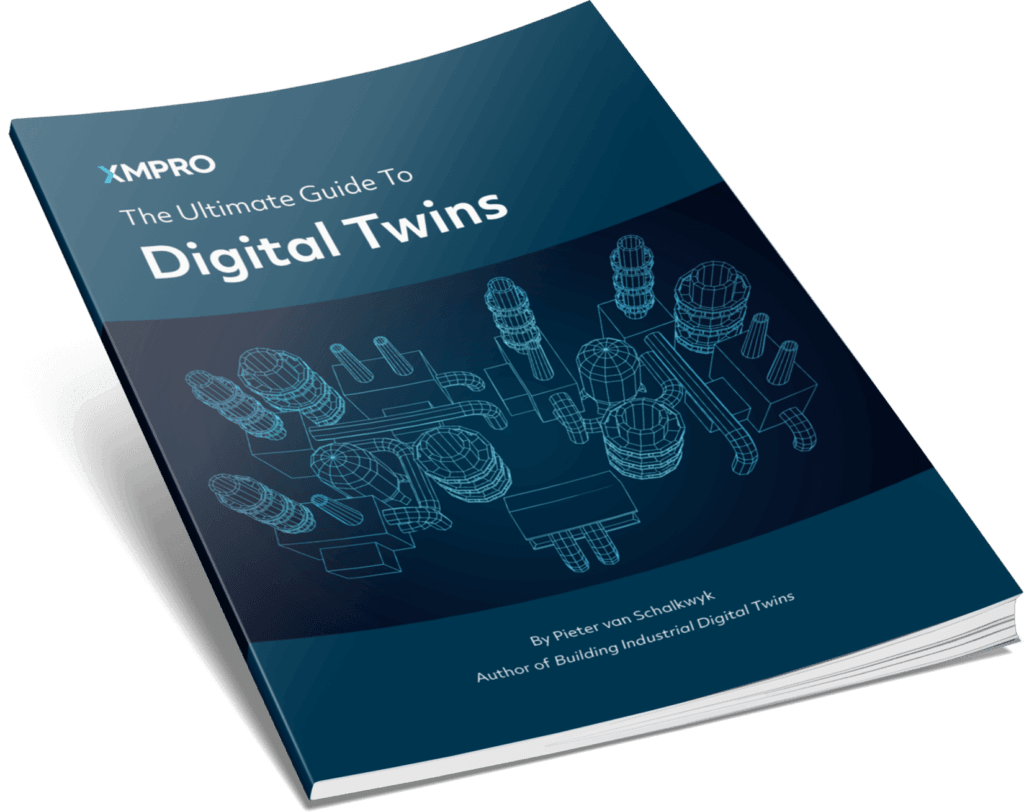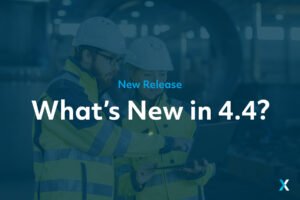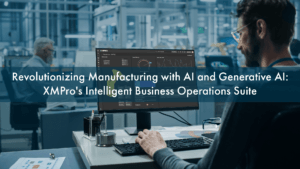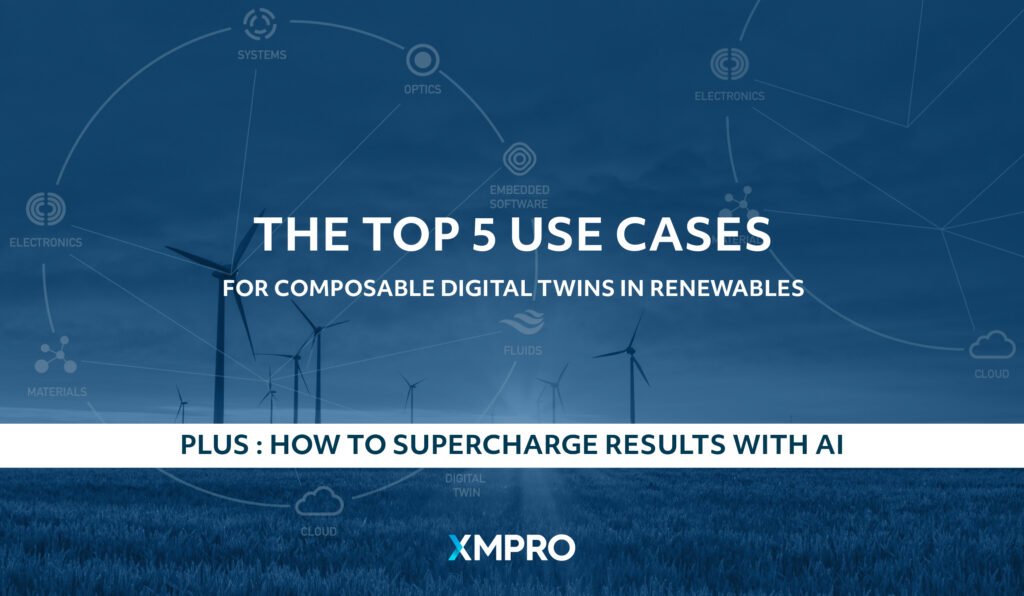
Introduction
Composable digital twins are revolutionizing the way organizations approach renewable energy management. Players that can successfully implement a composable digital twin strategy in the next 12 – 24 months will cement a decisive competitive advantage thanks to the benefits offered by digital twins.
In this article we will discuss the top 5 use cases for composable digital twins in the renewables sector, their associated benefits, and how companies can supercharge results using AI.
As a bonus we will also look at 5 lesser known use cases
A. Definition of Composable Digital Twin
A composable digital twin is a flexible and scalable digital twin that can be created and reconfigured to represent different components, systems, or processes. Unlike traditional digital twins , a composable digital twin allows for the creation of a virtual environment that mirrors the real-world operations of a system, providing a unified view of all relevant data, processes, and systems. This enables organizations to gain a comprehensive understanding of the system’s behaviour and identify areas for improvement. By utilizing AI technology, organizations can supercharge the insights and benefits provided by composable digital twins, making it a powerful tool in the renewable energy sector.
B. Importance of Digital Twin in renewables
The use of composable digital twins in the renewable energy sector brings numerous benefits, including:
- Improved decision-making: By providing real-time data and insights into system performance, composable digital twins can help organizations make informed decisions about the operation and maintenance of their renewable energy systems.
- Enhanced efficiency: By modelling the behaviour of complex renewable energy systems, organizations can identify inefficiencies and optimize their operations, leading to improved performance and increased energy output.
- Predictive maintenance: With the ability to monitor the performance of components and systems, composable digital twins can provide early warning of potential issues, allowing organizations to perform proactive maintenance and prevent costly downtime.
- Increased transparency: By providing a unified view of all relevant data, processes, and systems, composable digital twins increase transparency, enabling organizations to more easily identify and address issues.
- Reduced operational costs: By optimizing the performance of renewable energy systems, organizations can reduce operational costs and increase their return on investment.
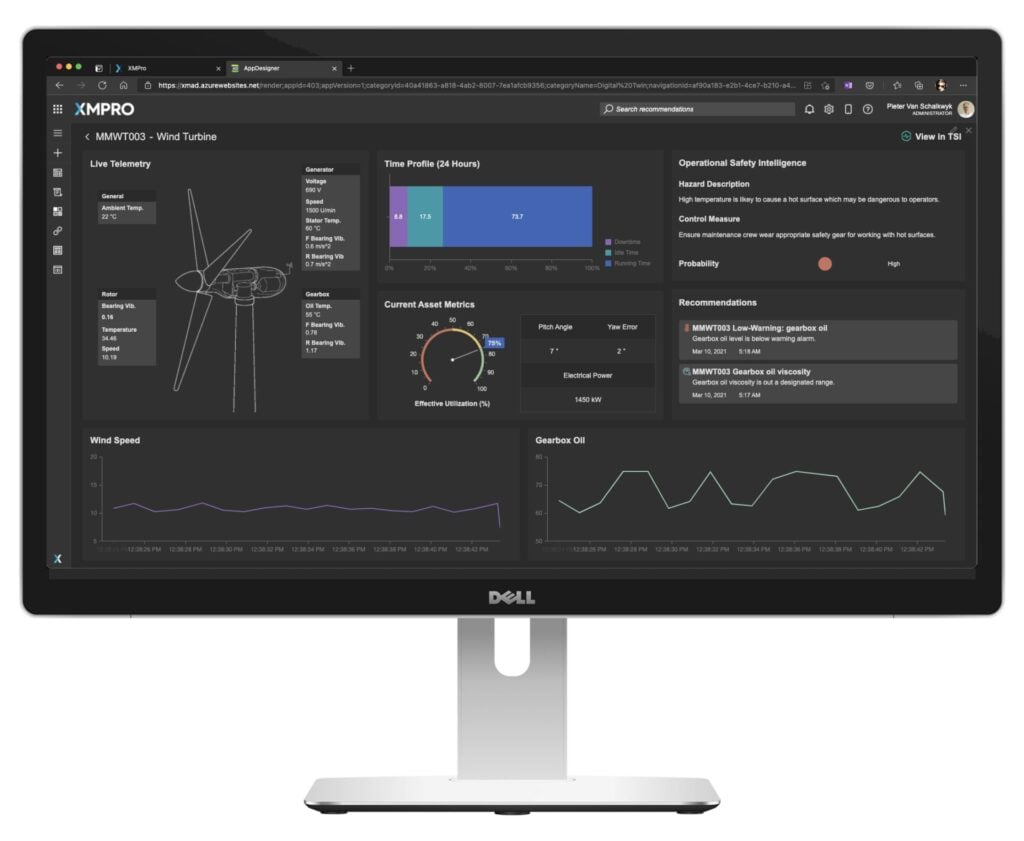
Use Case 1: Asset Performance Monitoring
A. Overview of the use case
A composable digital twin can provide you with real-time data on the performance of your renewable energy assets, enabling you to keep a close eye on any potential issues. This use case is all about optimizing performance and maximizing the lifespan of your assets.
With the help of AI, you can take asset performance monitoring to the next level. Predictive analytics algorithms can detect potential issues before they occur, reducing downtime and maintenance costs. Data visualization tools provide improved monitoring, enabling you to make informed decisions quickly.
By using composable digital twin for asset performance monitoring, you’ll have a complete, up-to-date view of your renewable energy assets, making it easier to ensure they are working optimally and delivering the results you need.
B. Benefits of using Composable Digital Twin for Asset Performance Monitoring
Benefits of using Composable Digital Twin for Asset Performance Monitoring:
- Early detection of potential issues: With predictive analytics, you can identify potential problems before they happen, reducing downtime and maintenance costs.
- Increased efficiency and cost savings: AI-driven optimization algorithms can help you get the most out of your assets, improving efficiency and reducing costs.
- Improved monitoring and decision-making: Real-time data visualization enables you to monitor performance and make informed decisions quickly, helping you to stay on top of things.
- Accurate data: By using a composable digital twin, you can be sure that you’re working with accurate, up-to-date data on the performance of your assets, helping you to make better decisions.
- Improved asset lifespan: Regular monitoring and maintenance can help to extend the lifespan of your assets, ensuring you get the most out of your investment.
With these benefits, it’s easy to see why using a composable digital twin for asset performance monitoring is an excellent choice for any renewable energy organization. By supercharging your results with AI, you can take your monitoring to the next level and stay ahead of the competition.
C. Supercharging Results with AI
As we’ve seen, the Composable Digital Twin has numerous benefits for Asset Performance Monitoring. But what if we took it a step further and utilized the power of AI to supercharge our results?
Here’s how:
- AI-powered Predictive Analytics: AI algorithms can be used to analyze data from the Composable Digital Twin to detect potential issues early on, before they become major problems. This allows for proactive maintenance and reduced downtime, improving overall asset performance.
- AI-driven Optimization Algorithms: AI algorithms can also be utilized to optimize asset performance, leading to increased efficiency and cost savings. By analyzing real-time data and making predictions, AI can help identify areas for improvement and make recommendations for optimizing performance.
- AI-powered Data Visualization: Lastly, the Composable Digital Twin’s data can be visualized using AI-powered tools, allowing for improved monitoring and decision-making. The data can be transformed into interactive, easy-to-understand visualizations that provide actionable insights into asset performance.
- AI-powered anomaly detection can help organizations identify and address issues before they escalate, improving the reliability and performance of their assets.
In conclusion, the combination of the Composable Digital Twin and AI leads to a powerful solution for Asset Performance Monitoring. With the ability to detect issues early, optimize performance, and provide clear, actionable insights, organizations can ensure that their assets are performing at their best and minimize downtime.
Use Case 2: Predictive Maintenance
A. Overview of the use case
In the context of renewable energy, predictive maintenance involves using data and analytics to predict when equipment is likely to fail, and performing maintenance before it actually does. This helps organizations reduce downtime, improve equipment reliability, and save on maintenance costs.
By using a Composable Digital Twin in predictive maintenance, organizations can access real-time, accurate data about the performance and condition of their equipment. This data, combined with advanced analytics and AI, can be used to predict when equipment is likely to fail, allowing organizations to perform maintenance before a failure occurs. Predictive maintenance helps organizations improve equipment reliability, reduce downtime, and save on maintenance costs, ultimately leading to improved overall efficiency and performance.
B. Benefits of using Composable Digital Twin for Predictive Maintenance
- Real-time condition monitoring: The Composable Digital Twin allows organizations to monitor the performance and condition of their equipment in real-time, providing a more accurate and complete picture of the equipment’s health.
- Improved maintenance planning: Predictive maintenance allows organizations to schedule maintenance before a failure occurs, reducing downtime and improving equipment reliability.
- Lower maintenance costs: By performing maintenance before equipment fails, organizations can save on the costs associated with emergency repairs and replacements.
- Improved equipment reliability: Predictive maintenance helps organizations improve equipment reliability by reducing the frequency of unplanned downtime and by performing maintenance before a failure occurs.
By using a Composable Digital Twin in predictive maintenance, organizations can unlock these benefits, leading to improved efficiency, reliability, and cost savings.
C. Supercharging Results with AI
- Real-time Equipment Health Monitoring: AI-powered monitoring tools are changing the game for predictive maintenance. With real-time, accurate assessments of equipment health, organizations can identify potential issues before they become critical problems.
- Smarter Maintenance Schedules: By incorporating AI into predictive maintenance, organizations can optimize maintenance schedules, reducing downtime and cutting costs. Say goodbye to guesswork and hello to data-driven decision making!
- Streamlined Efficiency: AI-enabled optimization of maintenance schedules can take your predictive maintenance efforts to the next level. With AI, organizations can streamline their maintenance processes, leading to even greater cost savings and improved equipment reliability.
- AI-driven Predictive Failure Analysis: Proactive Issue Resolution. AI is revolutionizing the way we approach predictive maintenance, and this includes taking proactive measures to avoid failures altogether. Predictive failure analysis uses AI algorithms to analyze data and predict when an issue might arise. This allows you to take preventative measures before the problem becomes critical, which reduces downtime, improves efficiency, and saves money. With composable digital twins, you can take advantage of AI-driven predictive failure analysis to keep your renewable energy systems running smoothly, avoid costly downtime, and supercharge your results.
Incorporating AI into predictive maintenance efforts is a no-brainer. Whether it’s through real-time equipment health monitoring, smarter maintenance schedules, or streamlined efficiency, organizations can unlock the full potential of predictive maintenance with AI.
Use Case 3: Grid Integration and Optimization
A. Overview of the use case
Renewable energy is becoming increasingly prevalent, and the ability to seamlessly integrate it into the grid is critical. Composable Digital Twin technology provides a powerful solution for grid integration and optimization. With the ability to provide real-time monitoring and analysis, this technology can help optimize the flow of energy and improve the stability and efficiency of the grid. In this section, we’ll explore the benefits of using Composable Digital Twin for grid integration and optimization.
B. Benefits of using Composable Digital Twin for Grid Integration and Optimization
The benefits of using the digital twin for grid integration and optimization are numerous:
- Improved grid stability: By using AI-powered demand response algorithms, operators can balance supply and demand in real-time, ensuring grid stability.
- Increased efficiency: AI-driven algorithms can optimize energy distribution, reducing waste and increasing efficiency.
- Enhanced decision-making: The real-time monitoring and visualization provided by the digital twin enable operators to make informed decisions about energy distribution, improving the overall performance of the grid.
With these benefits, the Composable Digital Twin provides an innovative solution for grid integration and optimization, enabling renewable energy to reach its full potential.
C. Supercharging Results with AI
By incorporating AI, the results of grid integration and optimization are supercharged. Here’s how:
- AI-powered demand response algorithms: With AI-powered demand response algorithms, the energy grid can respond to changes in demand in real-time, leading to improved stability and efficiency.
- AI-driven real-time grid monitoring: AI-driven monitoring allows for improved decision-making and reaction times, ensuring the smooth operation of the grid.
- AI-based grid optimization algorithms: AI-based algorithms can optimize the flow of energy, leading to increased efficiency and cost savings for both the energy providers and consumers.
Use Case 4: Renewable Energy Forecasting
A. Overview of the use case
Forecasting renewable energy production is critical for effective grid management and energy trading. Digital twins offer a new way to approach this challenge, providing real-time, accurate data on renewable energy production. With Composable Digital Twins, energy producers can optimize their operations, reduce costs, and maximize their return on investment. In this section, we’ll explore the use case of renewable energy forecasting and how it can be supercharged with AI.
B. Benefits of using Composable Digital Twin for Renewable Energy Forecasting
Accurate forecasting is critical to the success of renewable energy projects. The use of a digital twin in this context offers several benefits, including:
- Improved Forecasting Accuracy: A digital twin enables the integration of real-time weather and climate data, allowing for more accurate forecasting of renewable energy production.
- Real-Time Forecasting and Optimization: Predictive algorithms can be integrated into a digital twin to provide real-time forecasting, allowing for real-time optimization and improved decision-making.
- Data Visualization: A digital twin provides an easy-to-use, visual representation of renewable energy production, making it easier to analyze data and make informed decisions.
In summary, the use of a digital twin in renewable energy forecasting can help to improve forecasting accuracy, optimize renewable energy production, and provide a clear picture of renewable energy production, enabling better decision-making.
C. Supercharging Results with AI
Renewable energy forecasting is crucial for the success of renewable energy projects, as it helps to optimize the energy production and distribution process. The use of Composable Digital Twin technology in this field can supercharge the results, making the forecasting process even more accurate and efficient. Here’s how AI can enhance the process:
- AI-powered weather and climate data analysis: AI algorithms can process vast amounts of weather and climate data, providing more accurate and up-to-date information for forecasting.
- AI-based predictive algorithms: AI can use this data to make real-time forecasting and optimization decisions, providing a more precise and efficient process.
- AI-driven visualization tools: The use of AI-driven visualization tools can help to analyze and interpret the data, making it easier to make informed decisions. These tools can also provide real-time updates, allowing energy managers to make quick and informed decisions.
- AI-enabled integration of multiple data sources for improved forecasting accuracy: The integration of multiple data sources can greatly enhance the accuracy of renewable energy forecasting. AI algorithms can be leveraged to combine data from a variety of sources, including satellite imagery, weather forecasts, and historical data, to provide a more comprehensive picture of expected energy generation. With AI, the integration process is automated and optimized, reducing manual effort and increasing the speed at which data can be analyzed. This results in improved forecasting accuracy, which can inform decision-making processes related to grid management, energy storage, and energy trading.
With the help of AI, renewable energy forecasting can be transformed into a more reliable, efficient, and cost-effective process, providing significant benefits for renewable energy projects.
Use Case 5: Decentralized Energy Management
A. Overview of the use case
The energy sector is undergoing a major transformation as the world moves towards a more decentralized and sustainable energy future. Decentralized energy management is a key component of this shift, allowing for more efficient and cost-effective energy distribution and usage. A composable digital twin can play a crucial role in supporting this transition by providing real-time monitoring, management, and optimization of decentralized energy systems. This use case can help organizations achieve greater energy efficiency, cost savings, and overall sustainability in their energy management practices.
B. Benefits of using Composable Digital Twin for Decentralized Energy Management
In the energy sector, decentralization is becoming increasingly popular as it offers more control and flexibility over energy production, distribution and consumption. This approach is especially relevant for renewables, as it allows for more efficient use of local resources and reduces the dependence on large centralized energy sources.
Composable Digital Twin technology plays a crucial role in enabling decentralized energy management, by providing real-time monitoring, control, and optimization of energy systems at a local level. With the use of Digital Twin, energy management becomes more efficient, with improved decision-making capabilities, optimized energy distribution and reduced energy waste.
By using Digital Twin, energy providers can better understand local energy consumption patterns, allowing them to optimize energy production and distribution, leading to increased energy efficiency, cost savings, and reduced greenhouse gas emissions.
C. Supercharging Results with AI
In decentralized energy management, Composable Digital Twin supercharges results by utilizing AI in various ways. Some examples include
- AI-powered demand response algorithms: These algorithms help improve energy balancing and efficiency by using real-time data and machine learning algorithms to optimize energy distribution.
- AI-based real-time energy monitoring and management: With AI-powered monitoring and management, decision-making in decentralized energy management becomes more informed, timely and effective.
- AI-enabled optimization of energy distribution: The integration of AI algorithms in decentralized energy management helps optimize energy distribution, resulting in increased efficiency and cost savings.
- AI-enabled integration of multiple data sources: By integrating multiple data sources such as weather forecasts, energy usage patterns, and grid capacities, AI-enabled systems can improve the accuracy of energy forecasting and optimize energy distribution.
5 Less Well-Known Use Cases
A. Microgrids
Microgrids are small-scale energy systems that are independent of the main grid, providing power to communities and businesses. They offer a solution for communities who are looking for more control over their energy supply, increased reliability, and reduced costs. With a Composable Digital Twin, microgrids can take advantage of AI-powered optimization algorithms to increase energy efficiency, improve energy management, and minimize costs.
B. Hybrid Renewable Energy Systems
Hybrid renewable energy systems are becoming increasingly popular, combining the benefits of multiple energy sources to meet energy demands. A composable digital twin can be a powerful tool in optimizing and managing these systems, bringing together data from a variety of sources, including wind, solar, and energy storage systems. The digital twin allows energy professionals to monitor and manage the performance of each energy source in real-time, ensuring efficient and cost-effective energy production. With the help of AI, the digital twin can analyze data and predict potential issues, allowing for proactive maintenance and optimization. This leads to improved energy production, increased efficiency, and reduced costs. By using a composable digital twin for hybrid renewable energy systems, energy professionals can stay ahead of the curve and ensure that their systems are operating at their maximum potential.
C. Energy Storage Systems
Composable Digital Twin can help in effectively managing hybrid renewable energy systems by providing a unified view of the entire system. The digital twin can provide real-time monitoring and control of the system, allowing for optimized energy distribution and improved efficiency. With the help of AI algorithms, the digital twin can analyze data from multiple sources and make predictions on energy production and consumption. This information can be used to make informed decisions on energy distribution, improving the overall performance and efficiency of the hybrid renewable energy system.
D. Building-Integrated Renewables
Building-integrated renewables refer to the integration of renewable energy sources into a building’s design and construction. This not only reduces the building’s carbon footprint but also makes it more energy-efficient. Composable Digital Twin technology can be used to monitor and optimize building-integrated renewables, such as rooftop solar panels or wind turbines.
With AI-powered monitoring and optimization algorithms, building-integrated renewables can be managed more efficiently and effectively. This not only helps to reduce the building’s energy costs but also improves its overall sustainability. Real-time monitoring of energy production and consumption allows building owners and managers to make data-driven decisions on energy usage and make any necessary adjustments to ensure maximum efficiency and cost savings.
E. Electric Vehicle Charging
Using composable digital twin technology, energy providers can better manage and optimize electric vehicle charging networks. By integrating real-time data on vehicle battery levels, charging station availability, and energy usage patterns, energy providers can better plan and coordinate charging activities. With AI-powered algorithms, energy providers can predict energy demand, dynamically adjust charging speeds, and reduce the risk of grid overloading. This leads to improved energy efficiency, reduced costs, and a more seamless electric vehicle charging experience for drivers.
Conclusion
A. Recap of the Top 5 Use Cases and 5 Less Known Use Cases
In this blog post, we’ve explored the many ways that composable digital twins can be used to revolutionize the renewable energy industry. From asset performance monitoring and predictive maintenance to grid integration and optimization, renewable energy forecasting, and decentralized energy management, we’ve highlighted some of the most important and impactful use cases for digital twins in renewables.
But that’s not all! We’ve also touched upon five less well-known use cases, such as microgrids, hybrid renewable energy systems, energy storage systems, building-integrated renewables, and electric vehicle charging. These innovative applications showcase the versatility and potential of composable digital twins to drive progress in the renewables sector.
In conclusion, we hope this overview has provided valuable insights into how composable digital twins are set to change the face of the renewable energy industry, and how AI can supercharge the results of these use cases.
B. How to get started with Composable Digital Twins
Building a composable digital twin can seem like a daunting task, but it doesn’t have to be. The key to success is finding the right tools and platforms to help you get started. One platform that stands out in this regard is XMPro, the world’s only No-Code Digital Twin Composition Platform.
XMPro is designed to make it easy for organizations of all sizes to build and manage composable digital twins. With XMPro, you can create a digital twin of your assets, processes, and systems in a matter of minutes, without the need for complex coding or IT skills. The platform is user-friendly, intuitive, and offers a wide range of features and capabilities that are designed to help you quickly and easily build, integrate, and optimize your digital twin.
Some of the key benefits of using XMPro to build your composable digital twin include
- No-Code Composition: With XMPro, you don’t need to know how to code to build a digital twin. The platform’s drag-and-drop interface and intuitive workflows make it easy for anyone to build a digital twin, even if you have limited technical skills.
- Wide Range of Integrations: XMPro offers a wide range of integrations with other tools and platforms, making it easy to bring in data from multiple sources and integrate it into your digital twin.
- Advanced Analytics and AI: XMPro includes advanced analytics and AI capabilities, making it easy to monitor and analyze your digital twin in real-time. You can use the platform’s predictive analytics and AI-driven insights to make data-driven decisions and improve your operations.
- Scalability: XMPro is a scalable platform, making it easy to start small and grow as your needs change. Whether you’re a small organization or a large enterprise, XMPro can help you build a composable digital twin that meets your needs.
In conclusion, XMPro is a powerful, yet user-friendly platform that can help you build a composable digital twin quickly and easily. With its no-code composition capabilities, wide range of integrations, advanced analytics, and AI capabilities, XMPro is the perfect solution for organizations looking to build a composable digital twin. So if you’re ready to get started, give XMPro a try today!
















